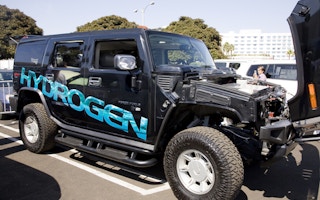We hear a lot about wind, solar and nuclear energy in the fight to reduce carbon emissions, but it seems we’ve forgotten about hydrogen fuel. Hydrogen — made by splitting water — was considered energy-intensive and expensive to make. But new plans for hydrogen fuel cells in cars show hydrogen made using renewable energy may yet get its time in the sun.
New hydrogen initiatives
Toyota, Hyundai and Honda are all planning production models of hydrogen fuel cell cars for release in 2015.
Meanwhile in Germany, energy company Enertrag is building a 500 kilowatt electrolyser system to generate hydrogen by splitting water. But instead of using the electricity grid (and fossil fuels), it is using surplus wind power at the new Berlin Brandenberg international airport. The hydrogen produced will supply electricity and heat, and fuel cell vehicles.
Last year the US Department of Energy launched H2USA, a partnership of automakers, gas suppliers, and hydrogen technology companies to support the development of hydrogen infrastructure and fuel cell electric vehicles. It was a signal that the Obama administration was changing its previous negative stance towards hydrogen.
A similar public-private partnership, the UK H2 Mobility Study, was formed in the UK.
Hydrogen is inextricably being linked to renewables in energy strategies to meet radical greenhouse targets. Hydrogen can store renewable energy for powering vehicles and supply 100 per cent reliable electricity.
Hydrogen held back
In 2003 US President George W. Bush boldly announced that America would lead the world in developing clean, hydrogen-powered automobiles. So how did hydrogen get stuck in the doldrums for so long?
Progress was steadily made in improving fuel cell performance, durability and costs. But there was no dramatic breakthrough in hydrogen storage. Solid-state metal hydride storages did not live up to their early promise, so that hydrogen gas compressed to 350 or 700 times atmospheric pressure remained the best option in terms of energy stored per unit mass and volume.
The radical nature of the shift from petroleum fuels to hydrogen started to scare many policy makers and corporate executives. Unlike biofuels, everything had to be changed with hydrogen: the fuel, storage and distribution infrastructure, and on-vehicle power unit.
Meanwhile advances continued to be made in lithium ion batteries for electric vehicles. The battery electric system appeared so much simpler and easier to introduce than the hydrogen fuel cell system.
The influential environmental movement has been ambivalent about hydrogen, because since the early 1970s the proponents of the “hydrogen economy” have often embraced production of hydrogen from fossil fuels and nuclear energy, as readily as from renewables.
Hydrogen and climate change
Our recent review of global and national “sustainable” energy strategies has found that understanding of the role hydrogen can play is still very patchy.
“
The costs of producing hydrogen from renewables by water electrolysis, and of fuel cells, have fallen over the past decade as dramatically as that for solar panels
The 2012 International Energy Agency’s World Energy Outlook clearly rang the alarm bells that current world energy policies are inexorably leading the earth to a rise in mean surface temperature of 3.6C, that is, well above the 2C that the IPCC recommends as the safe limit.
Energy efficiency was strongly recommended, but hydrogen is mentioned only once, and not as a fuel.
Like many governmental energy policy units, the IEA appears to have a blind spot with respect to hydrogen.
On the other hand, the IPCC report, Renewable Energy Sources and Climate Change Mitigation, included an essential role for hydrogen. Hydrogen fuel cell vehicles are expected to compete strongly with other low or zero emission options such as biofuels and electric vehicles.
A 2013 study showed hydrogen would have a vital role in meeting the UK’s carbon emissions goal. The report projected hydrogen would supply 85 per cent of road transport demand, and about 70 per cent of total transport demand in general by 2050.
The comeback
Hydrogen is now back on the agenda, for three main reasons.
First, hydrogen fuel cell vehicles can still provide a much greater range than battery electric vehicles, with a refuelling time of less than five minutes compared to six to eight hours for batteries.
Second, the costs of producing hydrogen from renewables by water electrolysis, and of fuel cells, have fallen over the past decade as dramatically as that for solar panels. For example, the high-volume production cost of fuel cells fell from $275 per kilowatt in 2002 to only $51 per kilowatt.
Third, we now understand that there are many severe constraints on biofuel production. These include competition with food production, and the use of water, land, and fertilisers.
Despite the emerging opportunities for hydrogen energy, Australia is virtually alone among developed countries in not having any demonstration or trial of hydrogen fuel cell vehicles and refuelling stations.
We have just one fuel cell manufacturer, Ceramic Fuel Cells, who make a high-temperature solid-oxide combined heat and power system for buildings, but no manufacturer of the lower-temperature Proton Exchange Membrane fuel cells for cars and stationary power.
At a time when the Australian automotive industry, and manufacturing industry generally, are searching for new directions, hydrogen technologies are now well worth detailed governmental and private sector investigation.
John Andrews is an associate professor at the School of Aerospace, Mechanical and Manufacturing Engineering at RMIT University. This post originally appeared here.








